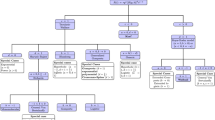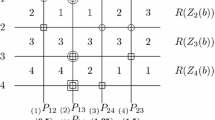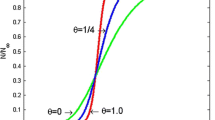Abstract
The parameter K of the von Bertalanffy equation, as developed by Beverton and Holt (1957), is first estimated by the relation
where dLt/dt denotes growth increments per a unit of age, t denotes age, and A is a constant. The K estimate is used to evaluate L∞;
The L∞ estimate is used to estimate t o, and to obtain a better estimate for K;
The K estimate may be used to obtain another estimate for L∞. Solved examples show that a single iteration is sufficient to obtain fitted equations which are, on the average, as precise as equations fitted by the least squares method shown by Tomlinson and Abramson (1961). This new method can be used, with a slight modification, for the second equation given above, if growth data have unequal age intervals. The variance of K, t o and log e L∞ can be estimated by applying the simple methods used in the case of straight-line relationships.
Similar content being viewed by others
Literature Cited
Allen, K. R.: A method of fitting growth curves of the von Bertalanffy type to observed data. J. Fish. Res. Bd Can. 23, 163–179 (1966).
Bertalanffy, L. von: A quantitative theory of organie growth (inquiries on growth laws. II). Hum. Biol. 10, 181–213 (1938).
—: Problems of organic growth. Nature, Lond. 163, 156–158 (1949).
Beverton, R. J. H. and S. Holt: On the dynamics of exploited fish populations. Fishery Invest., Lond. (Ser. 2) 19, 1–533 (1957).
Gulland, J. A.: Manual of methods for fish stock assessment. Part I. Fish population analysis. F.A.O. Fish. tech. Pap. 40 (Revision 1), 1–68 (1965).
Rafail, S. Z., W. L. Daoud and M. M. Hilal: Long-line Mediterranean fisheries studies west of Alexandria. Stud. Rev. gen. Fish. Coun. Mediterr. 42, 1–16 (1969).
—: Studies of populations and exploitation status of Egyptian Red Sea abundant sardines. Bull. Inst. Oceanogr. and Fish. (Cairo) 1, 129–149 (1970).
—: A new growth model for fishes and the estimation of optimum age of fish populations. Mar. Biol. 10, 13–21 (1971).
Southward, G. M.: A method of calculating body lengths from otolith measurements for Pacific halibut and its application to Portlock-Albatross grounds data between 1935–1957. J. Fish. Res. Bd Can. 19, 339–362 (1962).
Tomlinson, P. K. and N. J. Abramson: Fitting a von Bertalanffy growth curve by the least squares. Calif. Fish. Game Fish. Bull. 116, 1–69 (1961).
Walford, L. A.: A new graphic method of describing the growth of animals. Biol. Bull. mar. biol. Lab., Woods Hole 90, 141–147 (1946).
Author information
Authors and Affiliations
Additional information
Communicated by O. Kinne, Hamburg
Rights and permissions
About this article
Cite this article
Rafail, S.Z. A simple and precise method for fitting a von Bertalanffy growth curve. Marine Biology 19, 354–358 (1973). https://doi.org/10.1007/BF00348907
Accepted:
Issue Date:
DOI: https://doi.org/10.1007/BF00348907




